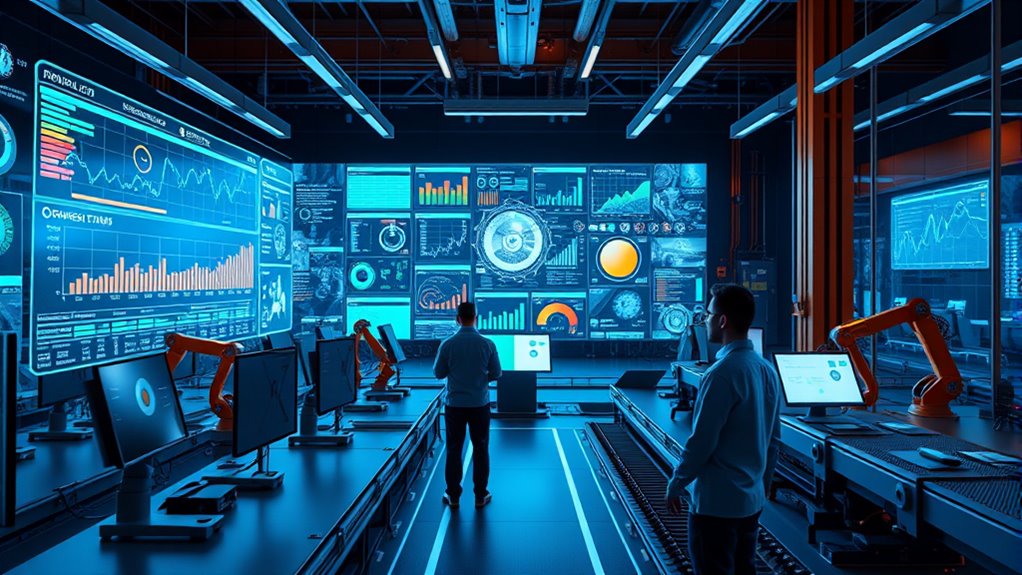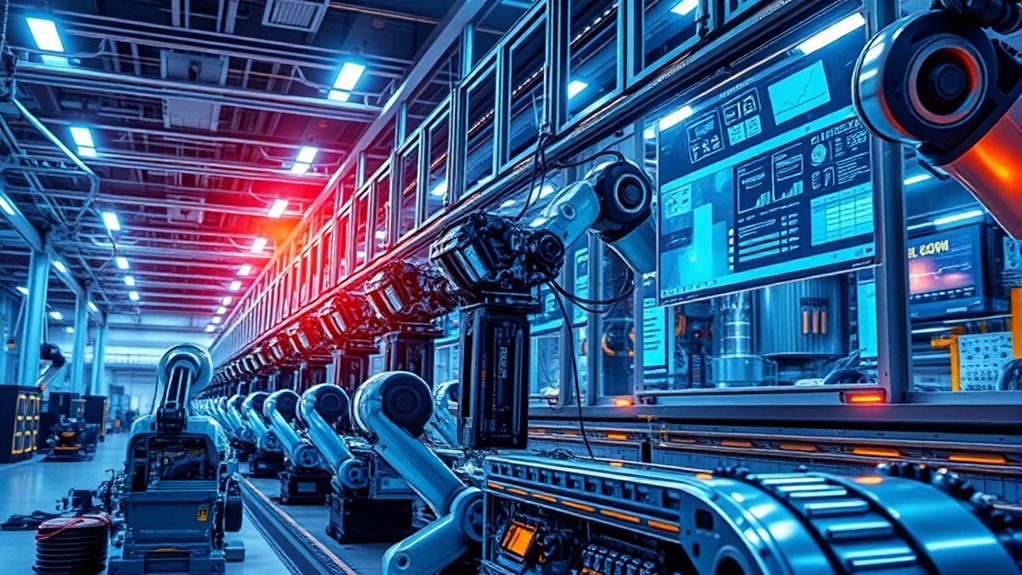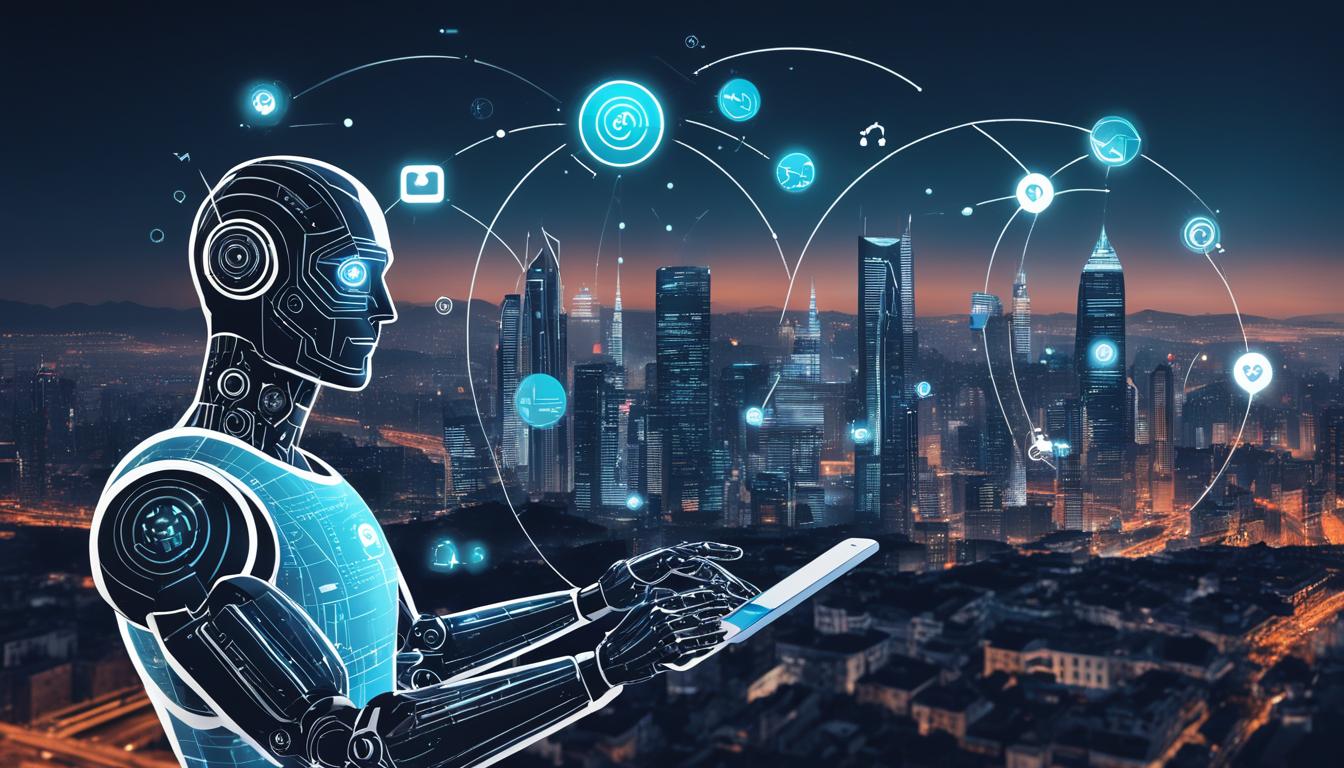Predictive Maintenance 2.0 uses AI and real-time sensor data to spot potential equipment issues before they cause failures. With embedded sensors monitoring parameters like temperature, vibration, and pressure, you get continuous insights into your machinery’s health. AI analyzes this data to detect patterns and anomalies, enabling you to schedule maintenance proactively and avoid costly downtime. This approach transforms factory operations into smarter, more efficient systems—keep exploring to see how it all comes together.
Key Takeaways
- Sensors continuously monitor equipment parameters, providing real-time data for early fault detection.
- Advanced AI analyzes sensor data to identify patterns and predict potential failures proactively.
- Machine learning models improve over time, enhancing prediction accuracy and maintenance planning.
- AI-driven feedback loops enable dynamic adjustments, preventing unexpected breakdowns before they occur.
- Integrating sensor insights with data analytics reduces downtime, extends equipment lifespan, and optimizes resource use.

Predictive Maintenance 2.0 transforms how industries anticipate and prevent equipment failures by leveraging advanced data analytics and artificial intelligence. Instead of reacting to breakdowns, you’re now empowered to identify issues before they escalate, minimizing downtime and saving costs. The key to this transformation lies in seamless sensor integration. Sensors are embedded into machines, capturing real-time data on temperature, vibration, pressure, and other critical parameters. These sensors act as the eyes and ears of your maintenance system, providing continuous, granular insights that were previously impossible to gather manually.
Seamless sensor integration captures real-time data to enable proactive, predictive maintenance and reduce costly downtime.
Once your sensors are in place, data analytics takes center stage. As data flows in from various sensors, sophisticated algorithms analyze this information to detect patterns and anomalies. This proactive approach means you can spot early signs of wear or malfunction, often long before a failure occurs. Instead of waiting for a machine to break down or require urgent repairs, you can schedule maintenance during planned downtime, optimizing operations and resource allocation. Data analytics also helps you prioritize maintenance efforts, focusing on equipment that shows the highest risk factors, which boosts efficiency and reduces unnecessary interventions.
The integration of sensor data with AI-driven analytics creates a powerful feedback loop. Your system continuously learns from new data, refining its predictions and becoming more accurate over time. This adaptive capability ensures that your predictive maintenance strategy stays relevant, even as machinery ages or operating conditions change. Furthermore, AI can identify subtle precursors to failure that might escape human detection, offering a level of precision and foresight previously unattainable.
Implementing sensor integration and data analytics also enhances your overall operational visibility. You get real-time dashboards that display the health status of equipment across your facility, allowing you to make quick, informed decisions. With predictive insights at your fingertips, you can plan maintenance activities more strategically, avoid unnecessary repairs, and extend the lifespan of your assets. This technological shift not only reduces costs but also boosts safety, as potential hazards can be identified and mitigated well in advance.
In essence, Predictive Maintenance 2.0 is about transforming raw sensor data into actionable intelligence. By harnessing the power of sensor integration and advanced data analytics, you move from a reactive approach to a predictive one, where your equipment “tells” you what it needs before issues become critical. It’s a smarter, more efficient way to keep your operations running smoothly and stay ahead of costly failures. Considering the importance of high-quality projectors in modern home cinema setups, integrating such technology can further enhance the viewing experience by ensuring your equipment operates reliably over time.
Frequently Asked Questions
How Does AI Improve Predictive Accuracy Over Traditional Methods?
You might wonder how AI improves predictive accuracy compared to traditional methods. Well, AI uses machine learning to analyze vast amounts of data quickly and identify patterns that humans might miss. Data analytics helps refine predictions by continuously learning from new data. This combination enables you to predict failures more accurately and early, reducing downtime and maintenance costs, making your operations more efficient and reliable.
What Industries Benefit Most From Predictive Maintenance 2.0?
Imagine factories humming smoothly, gears turning seamlessly. You’ll find manufacturing industries benefit most from Predictive Maintenance 2.0, as it boosts manufacturing efficiency and enhances equipment reliability. This advanced AI anticipates issues before they disrupt production, saving costs and minimizing downtime. Heavy industries like aerospace, automotive, and energy gain the most, where precision and continuous operation are critical. With Predictive Maintenance 2.0, you keep the production line flowing effortlessly.
How Is Data Security Maintained in Ai-Driven Maintenance Systems?
You guarantee data security in AI-driven maintenance systems by implementing robust cybersecurity protocols and data encryption. These measures protect sensitive information from cyber threats and unauthorized access. Regularly updating security practices and monitoring system activity help detect vulnerabilities early. By prioritizing cybersecurity and encryption, you maintain trust in your systems, ensure operations remain secure and reliable, even as AI manages critical maintenance tasks.
What Are the Initial Costs for Implementing Predictive Maintenance 2.0?
You should conduct a thorough cost analysis to understand the initial investment for predictive maintenance 2.0. These systems often involve high upfront costs, including hardware, software, and training. Be prepared for implementation challenges like integrating new AI tools with existing infrastructure. While the expenses can be significant, the long-term benefits of reduced downtime and maintenance costs often outweigh the initial investment, making it a strategic choice.
How Does AI Adapt to Evolving Machinery and Technology?
You’d think AI would get bored of old machinery, right? Not at all. It adapts through machine learning, constantly analyzing new data from sensor integration. As technology evolves, AI updates its models, improving predictions and responses. This way, it stays ahead of the curve, ensuring your equipment is maintained proactively. So, even as machines change, AI keeps learning and adjusting, making your maintenance smarter and more efficient.
Conclusion
With Predictive Maintenance 2.0, you can prevent costly breakdowns before they happen, saving time and money. Imagine reducing downtime by up to 30%, as some factories already have, thanks to smarter AI. By embracing this technology, you’re not just fixing problems early—you’re revolutionizing your factory’s efficiency. Stay ahead of failures and keep your operations running smoothly, knowing that AI is working behind the scenes to keep everything on track.









